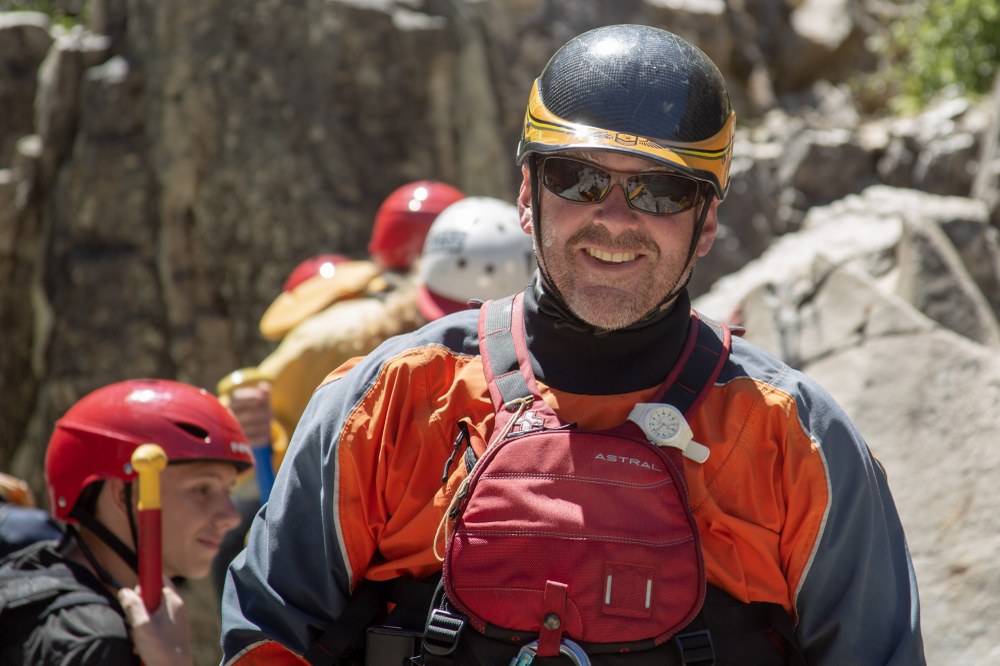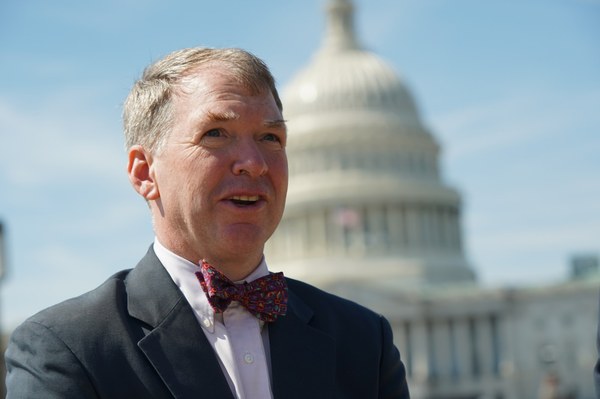
Thomas O’Keefe is a conservationist who is equally comfortable paddling a Class IV river as he is testifying before Congress (wearing his trademark bow tie). The longtime Pacific Northwest Stewardship Director for American Whitewater, Tom has dedicated his life to protecting whitewater rivers. Tom works closely with The Mountaineers to advocate for our wild places and provides strategic advice as a member of the Advisory Council. Here, we get to know Tom and learn what sparked his passion for protecting and stewarding public lands. Plus, we learn a great trick for recruiting Mountaineers members!
We’re catching you in between paddling trips. Tell us about your last trip and how you like to get outside.
I just got back from two weeks kayaking in the Idaho backcountry with my family. Given all that’s going on in the world, it was a great escape to just go out and spend time with family on public lands. Time outdoors with my family is one of the things I enjoy most. My parents took me outside to experience public lands, and I had that same opportunity with my kids over the past couple weeks.
What inspired you to get involved in conservation and advocacy?
I’ve always been interested in the stewardship of public lands. I grew up scouting. Civic engagement is part of the requirements for the Eagle Scout badge. I can still remember the first letter I wrote to my member of Congress as a teenager expressing my concern for the impacts of acid rain on the wild places and activities I enjoyed. At a very early age, I learned that I have a voice and can speak up to my member of Congress.
I got involved with American Whitewater shortly after I started seriously whitewater kayaking. Around 1996, I discovered that a river I had been paddling was impacted by a hydropower project. With the help of American Whitewater, I began to understand that there were opportunities for the public to speak up to government regulators.
Later on I did some contract work for American Whitewater, and then one day it was 40 hours a week. Reflecting back, I think some people go into conservation work as an intentional career choice, and then there’s other individuals such as myself who come in with a passion and enthusiasm. It begins as a volunteer endeavor and suddenly becomes much more than that.
How did you first get involved with The Mountaineers?
Shortly after I came to the Northwest I was on a project tour and someone wanted to get a picture of all the Mountaineers members. I wasn’t a Mountaineers member at the time so I was standing off to the side. The person organizing the photo said, “Oh Tom, you need to get in this photo, you’re part of The Mountaineers!” So I got in the photo, and it was published in a Mountaineers publication. I thought I’d better join if I’m being publicly identified as a Mountaineers member!
Aside from that, what drew me to the organization is its long history of conservation, education, and stewardship around public lands in the region. I can’t think of a better organization that connects to the importance of these places by recognizing that conservation is equally important as educating people on how to enjoy places safely and sustainably. I thought that if I’m going to live here in this region and these places are special to me, then I should join an organization that’s both working to care for these places and educating people on how to use them safely and sustainably. That’s something I wanted to support.
What advice do you have for Mountaineers members who want to do more to protect the places they love?
Identify the place or the project that really resonates with you personally. Whether it’s management decisions on a river, management decisions on climbing areas in Icicle Canyon, policies on backcountry use in the Okanogan-Wenatchee National Forest, or even something as mundane as the policy on bathroom use in the era of COVID-19, it’s trying to find that issue or project that resonates with you. Then you can identify the users, the land managers, and the decision makers. Starting to develop relationships with all three of those entities is a critical starting point.
Why should outdoor enthusiasts get involved in advocacy work?
I think about the adage “the world is run by those who show up.” The simple act of showing up and making your voice heard is important. There’s so many competing interests for our public lands, so articulating their value and importance is really critical. I’ve heard various conversations in the halls of Congress about the idea of selling or transferring public lands. There’s been pretty significant blowback to most of those proposals, but that’s only because the people who use these places speak up and make their voices heard.

Tom on a trip to DC to testify before the Senate Energy and Natural Resources Committee on outdoor recreation earlier this Congress. Photo by Caleb Hargett.
Why is it important for organizations like The Mountaineers and American Whitewater to work together?
None of us can do this work alone. All the critical successes I’ve had have only come about through a diverse spectrum of partners working together. Just look at what’s happening right now in Congress. I would argue that two of the biggest legislative achievements we’ve seen this Congress are related to public lands. There’s the Dingell Act, protecting over a million acres of wilderness and 600 miles of Wild and Scenic Rivers, which passed in 2019, and now we have the Great American Outdoors Act, which the President has signed into law. If someone had said 18 months ago the two biggest achievements in this Congress would be in the public lands space, no one would have believed you. But it happened because of partnerships: if those bills had just been a priority of The Mountaineers or one other organization, it wouldn’t have moved the needle. Those of us who value public lands should be really proud of what we’ve been able to accomplish by collectively working together in an extremely challenging political environment.
In your view, what makes The Mountaineers an effective advocate for protecting wild places?
I think it’s the authenticity of The Mountaineers. There are a lot of organizations that protect public lands, but what I really appreciate about The Mountaineers is that it’s an organization that authentically represents people who experience these places. When I’m interacting with elected officials, they can really tell if you’re just speaking from a bunch of talking points versus someone who can say “I climb every weekend at Vantage, and we need a toilet there!” You can deliver this authentic story and make it real. That’s what I think makes The Mountaineers so effective, is just the authenticity you bring to the dialogue on public lands.
how to get engaged
STAY UP-TO-DATE
Sign up for our Conservation Currents enewsletter (on the “preferences” tab of your My Profile page). We use it to send Action Alerts – updates that offer you breaking news and an opportunity to contact your legislators and land managers on urgent matters. And be sure to visit our advocacy page to get the latest conservation and advocacy news.
TAKE THE PROTECTING PUBLIC LANDS ELEARNING COURSE
This free 2-hour online course breaks down the basics of our national public lands system and explains how you can best advocate for our wild places.
VISIT OUR LEGISLATIVE TRAIL MAP
We work with legislators and partners to shape conservation policy. Our Legislative Trail Map serves to guide you through some of the legislation we’re working on and supporting in the current session of congress.
All this and more at mountaineers.org/conservation
This article originally appeared in our Fall 2020 issue of Mountaineer Magazine. To view the original article in magazine form and read more stories from our publication, visit our magazine archive.
 Betsy Robblee
Betsy Robblee